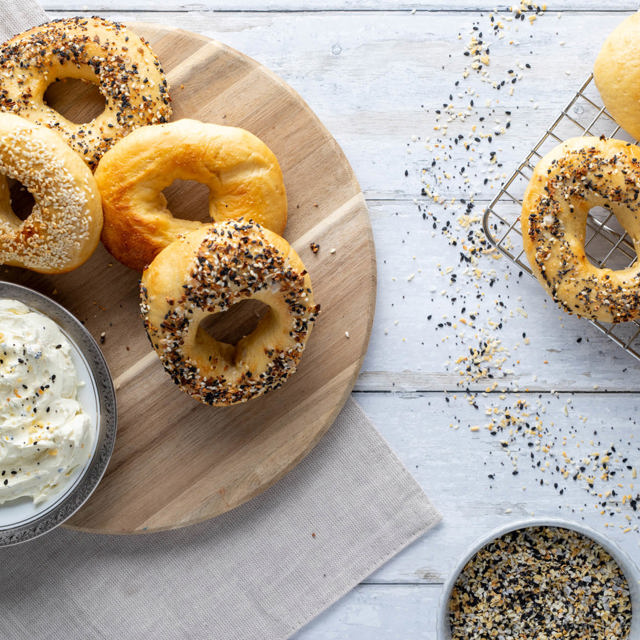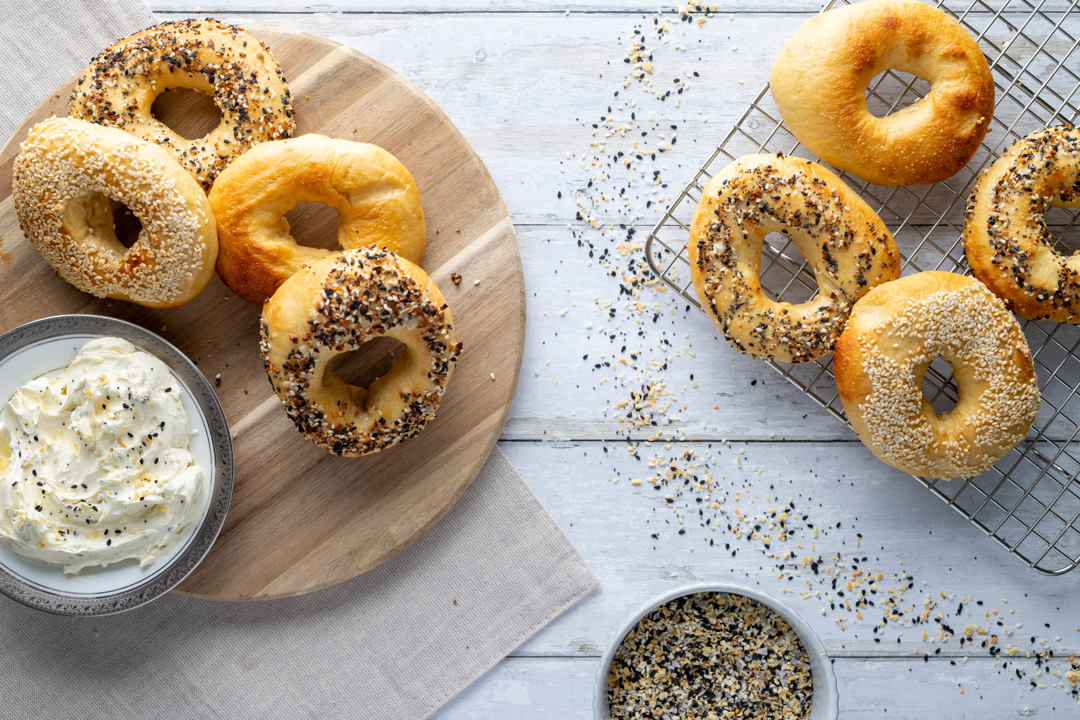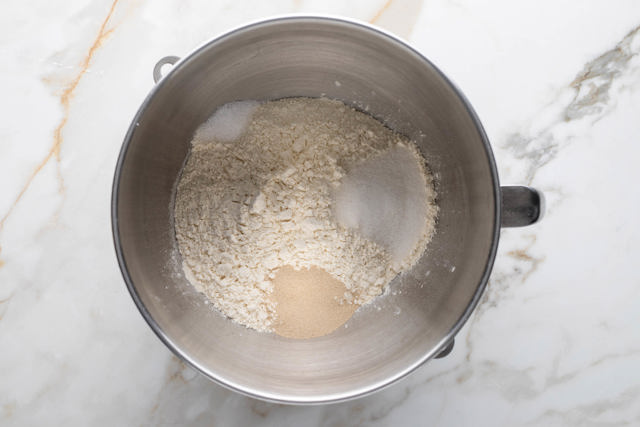Loved the world over for their soft and chewy texture, bagels are an easy bread to make and a perfect starter bread recipe. Easily made with basic pantry ingredients, these can be ready in as little as about an hour and a half, or you can do a slow ferment overnight to increase the flavour in the bread.
This recipe is for New York style bagels. The other main style of bagel - Montreal bagels - are smaller, thinner and sweeter than the New York style bagels. These NYC bagels are perfect for serving with smoked salmon or lox bagels, or enjoying with your favourite fillings.
This is a perfect recipe for getting the kids involved - mine love making eating the bagels - and because you don't need any special equipment and the dough is low hydration, it's easily approachable.
If you don't live in a large city, chances are your only source for bagels are from the supermarket. Supermarket bagels are often sent to the store frozen and then placed on the shelf to thaw and have a fairly long shelf life. If that's all you've tried, you're really missing what the bagel experience is all about.
The recipe is written for a stand mixer but I include instructions and advice for how to make the dough without using a mixer.
What are bagels?
Bagels are a ring shaped bread that is boiled and then baked, and often topped with a variety of seeds such as sesame, poppy or a everything bagel seasoning mix.
How to use bagels?
Use bagels as you would with any other roll or bread. A popular type of bagel is a smoked salmon or lox bagel which is filled with a herby cream cheese spread, salmon, capers and onion. You can also make bagel crisps with leftover stale bagels.
What you need to make bagels
This recipe is written for use with a stand mixer. If you don't have a stand mixer you can make them by hand - I have instructions below.
Be aware that this is a low hydration dough. This means that it's easier to work by hand as it's not too sticky, but conversely means that it's a difficult dough for a stand mixer to knead. If you have an inexpensive mixer it might be too firm for the mixer to knead. Use a slow speed and if the motor is stalling or struggling do it by hand. Kitchenaid mixers are fine with this dough.
Bagel ingredients
Bagels are made from a typical bread mix, containing:
- Flour
- Water
- Sugar
- Salt
- Yeast
Additionally, for toppings you optionally require:
- Poppy seeds
- Sesame seeds
- everything bagel seasoning mix - this contains poppy seeds, sesame seeds, onion flakes, garlic flakes and salt and is very popular!
For boiling:
- Barley malt extract - this is optional but recommended given it gives the characteristic taste, texture and colour to the outside of the bagel.
- Water
How to make bagels
Add dough ingredients to bowl - add the flour, yeast, salt and sugar to a mixing bowl. Take care to not put the yeast and salt together (1). Add the water (2).
Knead in your stand mixer at low speed with a dough hook attachment or by hand for 8 minutes until the gluten is developed and passes the window pane test.
Bulk ferment - cover with plastic wrap or a towel and allow the dough to ferment at room temperature for an hour or until doubled in size (1). Alternatively, you can place in the fridge overnight (see instructions in post). When the dough has doubled in size, degas it (2) by pulling it away from the sides or pushing down on it.
Divide the dough into equal sized balls. For the standard recipe quantity, divide the total dough weight by 8 which should yield balls around 100g each.
Shape - pull the corners of the dough ball into the middle (1). Place seam side down (2) and cup with your hand. Grip loosely and roll the ball around for 5 seconds or so until it develops tension and is rounded (3). Repeat for each dough ball and place each ball on a baking paper/parchment paper lined tray (4).
Rest - allow the gluten to relax for 5-10 minutes to make shaping easier.
Shape - The easiest way is to use your thumb to create a hole in the centre of the dough ball by pushing your thumb and index finger through the center and gently stretching the dough to form a ring shape. Rotate the dough ring and use your fingers to enlarge the hole slightly. Alternatively, you can roll the dough portion into a rope shape 20-25cm (8-10") long. Then, wrap the dough rope around your hand, overlapping the ends by an inch or two. Roll the overlapping ends together on the work surface to seal and form a ring. Finally, gently roll the shaped bagels back and forth on the work surface to even out the shape and ensure a uniform thickness. Repeat for all the bagels.
Prove loosely cover the bagels with a towel or cling wrap and allow the dough to rise for 20-30 minutes. Bagels should not be airy in the way a bread roll is, but having a little rise helps you get the correct bagel shape.
Prepare toppings if you're using toppings for the bagel, place each topping you're using on a plate.
Prepare water - right before you start cooking the bagels, add the water to a large diameter pot along with the barley malt extract, if using (1). Bring the pot to the boil (2), and stir well so the malt extract is well incorporated into the water. Adjust the temperature to a gentle boil as a vigorous/rolling boil is too strong for the bread. Preheat your oven to 230C (450F).
Cook bagels - working in batches, carefully remove bagels from the parchment paper, taking care to not degas them. Add the bagels to the pot (1). Cook for 1 minute and then flip and cook for a further minute. Use a spider, slotted spoon or tongs to remove the bagels and place onto the toppings while still warm and steaming (2 & 3, if using) or directly onto a cooling rack (4). Repeat until all bagels are cooked.
Bake - bake the bagels in the preheat oven on a tray lined with baking/parchment paper for 9 minutes.
Tips
- It's claimed that rolling the bagels yields a better textural result. In my testing, I noticed no difference between rolling or stretching the dough using my fingers. Use whichever method you prefer.
- To help the yeast activate, make sure the water in the dough is lukewarm - around 35-40C (95-104F).
- If your dough is not rising you can try doing the bulk ferment in an oven set to 35C.
- If you're using active dried yeast, or If you're unsure your instant dried yeast is still alive, whisk the yeast, water and sugar together before adding to the flour and other ingredients. Allow it to stand for 10 minutes - if the yeast is alive the water will be frothy.
- Using bread flour will result in a chewier bagel due to the higher protein content.
- Store your dried yeast in the freezer to prolong its life.
- If you can find it, use barley malt extract. In the ingredient list it's listed as optional, but it adds a characteristic flavour and texture to the bagels.
Active dried yeast
Dried yeast comes in 2 varieties, active and instant. If you're using active dried yeast, you need to activate it before use. Simply mix the water, yeast and sugar together until frothy - about 10 minutes, and then proceed with the recipe.
Which type of flour should I use?
Any flour with a protein content of 10% or more will work fine. In Australia, most "all purpose"/plain flour meets this protein amount - look for at least 10g protein per 100g in the nutritional information panel.
Using flour under 10% protein will not have the right amount of chew.
Using bread flour which typically is 11-13% protein will result in a chewier texture.
Do I have to use barley malt extract? Where do I find it?
You don't need to use it. However, using it gives bagels their characteristic colour and contributes to their taste and texture, so I suggest that if you can find it you give it a go. You'll find it in larger supermarkets.
How do I knead by hand?
To knead dough by hand, begin with a lightly floured surface to prevent sticking. Place the dough on the floured surface and use the heel of your hand to gently press it away from you. Fold the dough in half towards you and rotate it a quarter turn. Continue this process for about 8-10 minutes or until the dough becomes smooth, elastic, and passes the "window pane test".
To perform the window pane test, take a small piece of dough and gently stretch it between your fingers. If the dough stretches into a thin, translucent membrane without tearing, it's ready. If it tears easily, continue kneading for a few more minutes.
While you're kneading, adjust the flour as needed to maintain a slightly tacky but not overly sticky consistency.
Using a stand mixer
Use your stand mixer on a low speed - generally 1 or 2, but consult your manual to confirm - with a dough hook to knead the dough.
This is a low hydration dough which makes it difficult for a stand mixer to mix. If you have a less expensive mixer, keep an eye on it while it's kneading and stop if the motor starts to smell, gets excessively hot, stalls or is regularly slowing down. Kitchenaid mixers are fine with this hydration.
Toasting bagels
Bagels are great toasted. The outside is meant to remain untoasted, so if you're using a toaster use the bagel or crumpet setting if your toaster has it to toast the inside of the bagel only.
I like to cook them in a frying pan with a knob of butter as I like the taste and texture that I get.
Overnight fermentation
Fermenting the dough overnight rather than at room temperature will give you a stronger fermented bread taste.
To do this, place your dough mixture after kneading into the fridge. Ensure that it's airtight so that it won't dry out in the fridge - either place into a container with a lid or cover your bowl with plastic wrap.
When you're ready to continue, remove the dough from the fridge and allow to come to room temperature before you proceed with shaping.
Why boil bagels?
Boiling the bagels does a few things, which contribute to the characteristic taste and texture of bagels:
- Adds colour and taste to the bagel when used with malt syrup.
- Prevents the bagel from rising too much in the oven, resulting in a denser bread. It partially cooks the bread on the outside, stopping too much expansion.
- Develops the gluten which contributes to the elasticity.
What to do with the bagels?
- Smoked salmon or lox bagels.
- Enjoy simply with cream cheese.
- Use in place of a roll for your favourite salad mix or spreads like jam and peanut butter.

Bagels
| Prep | Cook | Total |
|---|---|---|
| 15 mins | 20 mins | 90 mins |
- 500g plain/all purpose flour at least 10% protein content, bread flour is OK - see note 1
- 300ml water ideally at 35-40C/95-104F
- 25g sugar
- 8g salt
- 2 tsp instant dried yeast see note 2
- Poppy seeds
- Sesame seeds
- Everything bagel mix
- 4 tbsp barley malt extract optional but recommended, see note 3
- 1.5L water
- Add dough ingredients to bowl - add the flour, yeast, salt and sugar to a mixing bowl. Take care to not put the yeast and salt together. Add the water.
- Knead in your stand mixer at low speed with a dough hook attachment or by hand for 8 minutes until the gluten is developed and passes the window pane test.
- Bulk ferment - cover with plastic wrap or a towel and allow the dough to ferment at room temperature for an hour or until doubled in size. Alternatively, you can place in the fridge overnight (see note). When the dough has doubled in size, degas it by punching down.
- Divide the dough into equal sized balls. For the standard recipe quantity, divide the total dough weight by 8 which should yield balls around 100g each.
- Shape - pull the corners of the dough ball into the middle. Place seam side down and cup with your hand. Grip loosely and roll the ball around for 5 seconds or so until it develops tension and is rounded. Repeat for each dough ball and place each ball on a baking paper/parchment paper lined tray.
- Rest - allow the gluten to relax for 5-10 minutes to make shaping easier.
- Shape - The easiest way is to use your thumb to create a hole in the centre of the dough ball by pushing your thumb and index finger through the center and gently stretching the dough to form a ring shape. Rotate the dough ring and use your fingers to enlarge the hole slightly. Alternatively, you can roll the dough portion into a rope shape 20-25cm (8-10") long. Then, wrap the dough rope around your hand, overlapping the ends by an inch or two. Roll the overlapping ends together on the work surface to seal and form a ring. Finally, gently roll the shaped bagels back and forth on the work surface to even out the shape and ensure a uniform thickness. Repeat for all the bagels.
- Prove loosely cover the bagels with a towel or cling wrap and allow the dough to rise for 20-30 minutes. Bagels should not be airy in the way a bread roll is, but having a little rise helps you get the correct bagel shape.
- Prepare toppings if you're using toppings for the bagel, place each topping you're using on a plate.
- Prepare water - right before you start cooking the bagels, add the water to a large diameter pot along with the barley malt extract, if using. Bring the pot to the boil, and stir well so the malt extract is well incorporated into the water. Adjust the temperature to a gentle boil as a vigorous/rolling boil is too strong for the bread. Preheat your oven to 230C (450F).
- Cook bagels - working in batches, carefully remove bagels from the parchment paper, taking care to not degas them. Add the bagels to the pot. Cook for 1 minute and then flip and cook for a further minute. Use a spider, slotted spoon or tongs to remove the bagels and place onto the toppings while still warm and steaming or directly onto a cooling rack. Repeat until all bagels are cooked.
- Bake - bake the bagels in the preheated oven on a tray lined with baking/parchment paper for 9 minutes.
- Flour - use at least 10% protein content all purpose/plain flour.
- Barley malt extract - optional but recommended. The use of malt extract contributes to the characteristic taste and texture of bagels. You can find it in most supermarkets or online.
- Yeast - If you're using ACTIVE dry yeast (as opposed to instant) the yeast needs to be activated. Mix the sugar, water and yeast together until frothy (about 10 minutes) then proceed with the recipe.
- Overnight bulk ferment - optional step which yields a stronger bread taste. Place kneaded dough into an airtight container and into the fridge overnight. When you're ready to continue, remove the dough from the fridge and allow to come to room temperature before you proceed with shaping.
- Water - if you're making a large batch, there's no need to increase the water. Just top it off with boiling water from a kettle if needed.









































